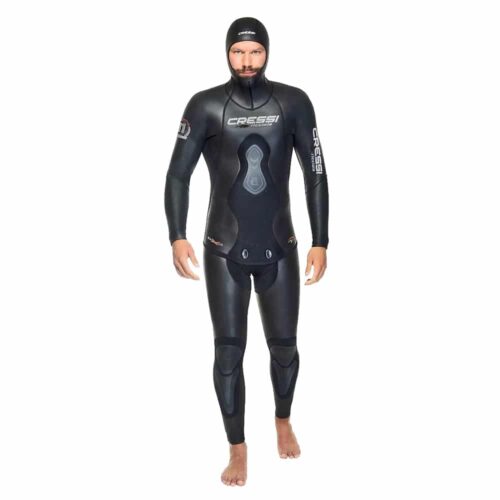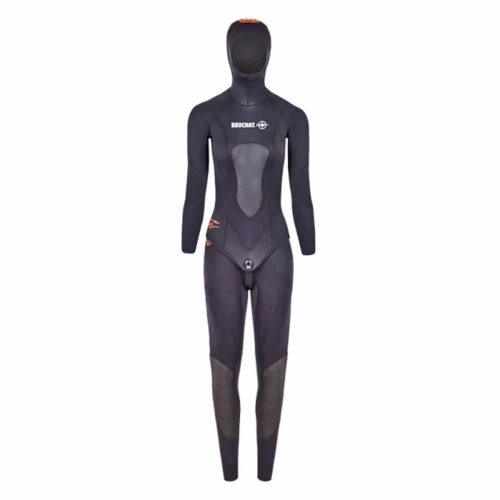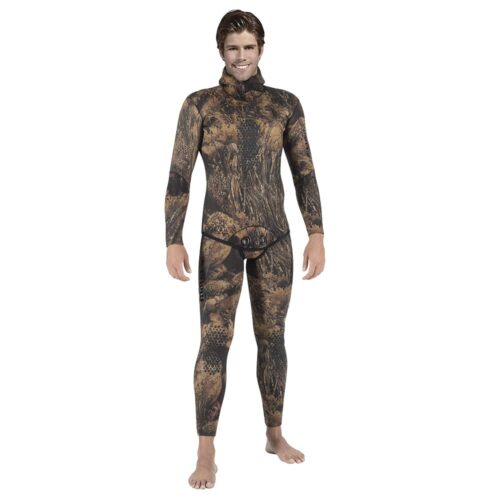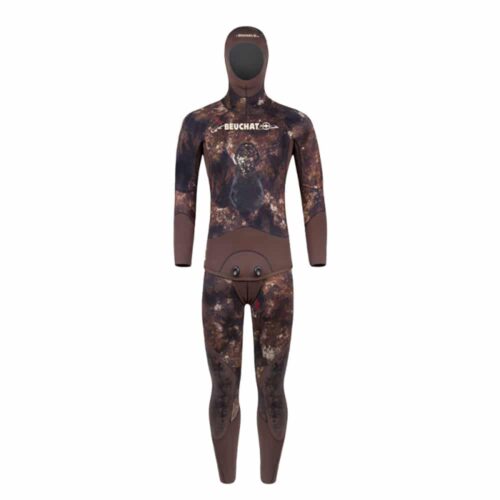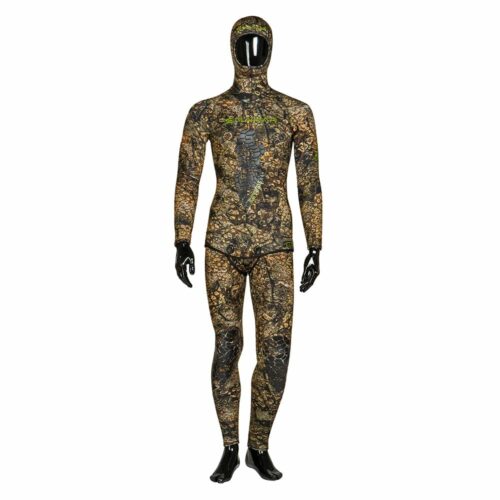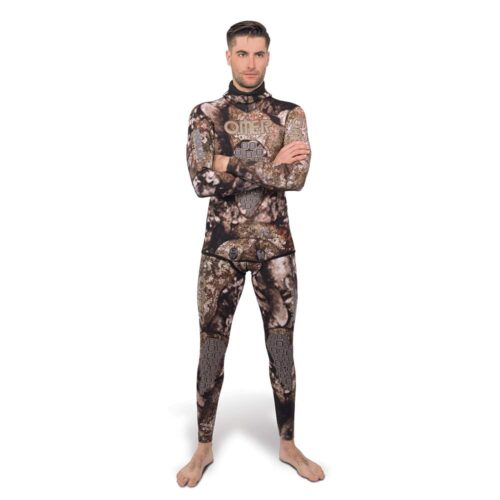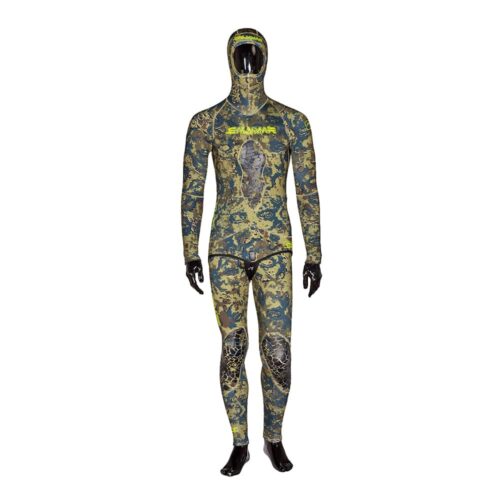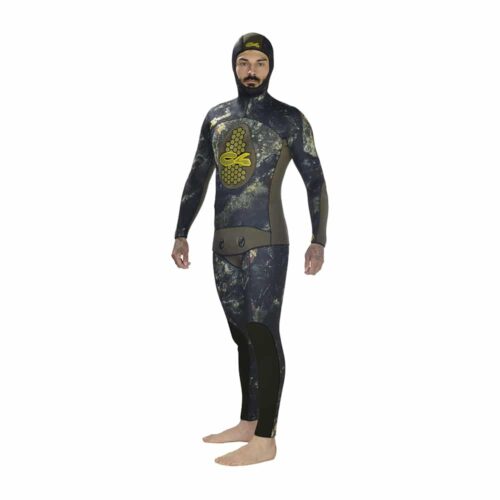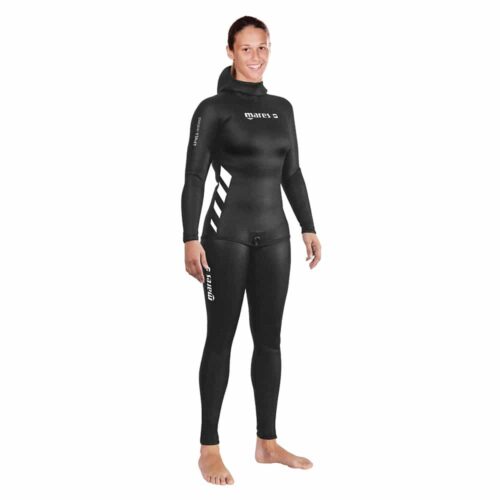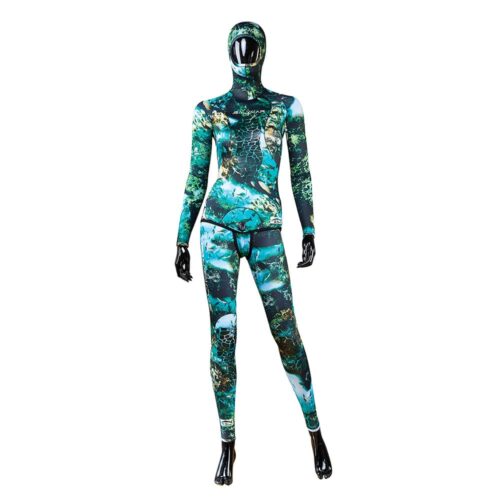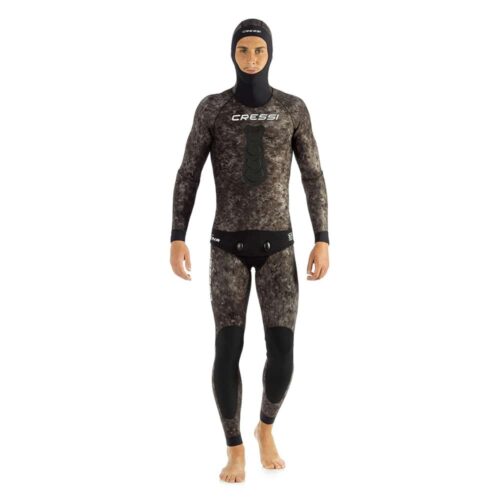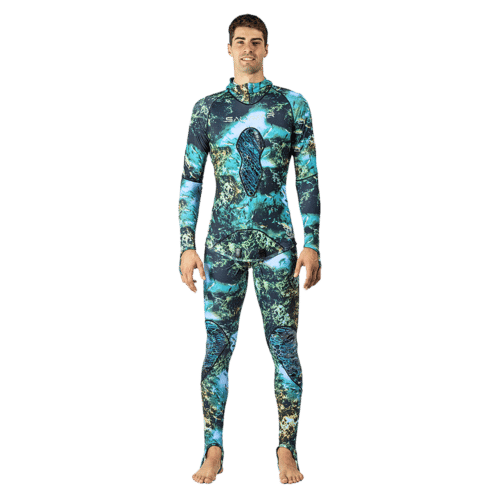La neoprene wetsuit è an essential tool for making apnea and spearfishing. It shields us from the rapid cooling that a body immersed in liquid produces and protects us from contact with the seabed or unwanted marine organisms. It allows us to move calmly underwater, achieving our goals safely and effectively.
But what are the different types of wetsuits and their characteristics? To learn more about which wetsuit is best for you, read on and find out everything you need to know about the neoprene wetsuits for freediving fishing.
SPEARFISHING SUITS
Wetsuits specifically designed for freediving offer many advantages over wetsuits intended for scuba diving or other water sports. The best spearfishing wetsuits are divided into two pieces, jacket and pants, and are zipperless. These wetsuits allow greater freedom of movement, are warmer for the same thickness, and allow a higher level of comfort in the water.
The outer surface of the neoprene of a spearfishing wetsuit can be lined or smooth, while the inner surface can be split, lined or coated neoprene, this allows different needs and personal preferences to be met.
Neoprene, plain or lined, can have neutral patterns or camouflage colors, and thicknesses ranging from 1.5 mm to 8.0 mm, to meet different thermal insulation requirements.
WHAT IS NEOPRENE?
Neoprene is a synthetic rubber, produced by the polymerization of chloroprene, a derivative of petroleum or natural latex. It is valued for its weather resistance, flexibility and thermal insulation, used in various industrial, commercial and sports sectors.
Some companies use calcium carbonate extracted from limestone rocks for neoprene production, which makes neoprene production much more sustainable than petroleum-derived neoprene.
Quality neoprene is known for its high density, closed-cell structure, increased flexibility, durability and superior insulating properties, ideal for wetsuits and other sports applications.
THE BEST NEOPRENE COMPANIES
Neoprene companies are mainly located in Asia, with Japan leading the way for its production of high-quality neoprene.
Below are some of the companies and brands of neoprene most commonly used for making wetsuits for freediving and spearfishing:
YAMAMOTO - Japanese company, has always been synonymous with the highest quality and sustainability. They pioneered the production of narrow cell neoprene. Yamamoto uses calcium carbonate extracted from limestone rocks (limestone) and food-grade oils to produce their neoprene, which makes their production much more sustainable than that of other companies that instead use petroleum or latex derivatives to produce neoprene, which, in addition to being less sustainable, can create allergic reactions in contact with the skin.
Yamamoto offers various types of neoprene suitable for making wetsuits, such as yamamoto 39, prized for its excellent value for money, or yamamoto 45 neoprene, prized by professionals for its incredible elasticity, strength and insulation properties.
HEIWA - Japanese manufacturer of high-quality neoprene. Heiwa manufactures various types of neoprene for making wetsuits for freediving and spearfishing. Wetsuits made of Heiwa are highly valued by deep-sea divers because while maintaining excellent thermal seal and comfort, they allow constant control of'buoyancy during descent, limiting the'free-fall effect due to'excessive neoprene crushing, which also compromise the wetsuit's insulation.
DAIWABO - Another Japanese manufacturer known for high-quality neoprene used by freediving and spearfishing wetsuit manufacturers worldwide.
SHEICO - Taiwanese company among the largest water sports neoprene manufacturers in the world.
NAM LIONG - Taiwanese company that produces neoprene for various applications, including wetsuits.
TYPES OF NEOPRENE
Neoprene sheets for wetsuits for freediving and spearfishing can have a wide variety of characteristics of density, buoyancy, strength and elasticity. But neoprene sheet can also have different types of surface finishes.
Neoprene sheet may have the same finish on both sides or but, as is often the case with sheets intended for the production of wetsuits, they may have two different types of finish. Let us look at the most common ones below:
Neoprene Lined / Split
The neoprene sheet used in the construction of the wetsuit has a jersey lining on the outside and a sharp neoprene cut on the inside, called a Split.
The textile liner, usually nylon or Lycra, is joined to the outer surface of the neoprene sheet by solid bonding and can have varying degrees of elasticity, as well as a variety of colors and camouflage patterns.
Split neoprene is so called because it is nothing'but the surface of the neoprene as it appears once cut. Thicker sheets of neoprene are sectioned off to make thinner sheets suitable for making wetsuits.
Looking at the surface of the split neoprene, microbubbles (dissected) present in the neoprene are exposed and clearly visible, and there is a feeling of looking at a porous or uneven surface. To the touch, the split has a noticeable "grip" and a soft texture.
Split neoprene has the characteristic of "sticking" to the skin, allowing superior adhesion to the diver's body and thermal insulation.
There is a variant of split neoprene referred to as "coated." Basically, a very light metallic film is applied to the split neoprene, making it easier to wear.
Neoprene Smooth / Split
The sheet of neoprene used in the construction of the wetsuit has a perfectly smooth and uniform finish on the outside, while on the inside is the sharp cut of split neoprene.
The smooth surface of neoprene is a feature imparted during the production of the sheet inside the mold. From each mold, once the neoprene is sectioned into sheets of lower thickness, only two sheets can have the smooth finish on one side. The two sheets in direct contact with the mold.
In some cases, a surface coating, i.e., a film such as Yamamoto's SCS or other polyurethane coatings that have the'goal of making smooth neoprene even more hydrodynamic, increasing the freediver's glide through the water and thus his or her speed of movement in the liquid, can be applied to smooth neoprene.
Neoprene Smooth / Lined
The neoprene sheet used to construct the wetsuit has a smooth finish on the outside, while the inside has a stretch lining made of nylon, Lycra or other materials.
Neoprene Sandwich
The sheet of neoprene used in the construction of the wetsuit is the result of bonding two sheets of neoprene with a liner in between. The sheet that will make up the inner part of the wetsuit will have a split finish, while the sheet that will make up the outer part of the wetsuit will have a smooth finish. With the neoprene sandwich, an attempt is made to combine the benefits of smooth/cracked neoprene with those of lined/cracked neoprene.
Bi-Lined Neoprene
The neoprene sheet used in the construction of the wetsuit has a lining on the outside and a liner on the inside. Basically, the neoprene sheet is enclosed between two liners.
NEOPRENE LINED/SMOOTH NEOPRENE vs.
In the collective imagination, smooth/split wetsuits are superior in quality to lined/split neoprene wetsuits. But this, for the same neoprene, is false. These are merely two products with different characteristics. Let's see which ones.
Lined/split wetsuits, worldwide, are the most widely used by freedivers and spearfishers of all levels. This is due to the characteristics of neoprene, which, on the inner side in contact with the skin, is of the split type, very thermal and comfortable. While on the outside it has an elastic lining, which prevents the fragile neoprene from breaking.
The outer liner greatly increases the wetsuit's strength both during donning and on occasions of contact with the seabed or sharp elements. In addition, the lining allows the use of reduced thicknesses of neoprene, which would be difficult to use without the lining because they would be too prone to breakage. Finally, the lined neoprene panels that make up the wetsuit are sewn, as well as glued, greatly increasing the wetsuit's strength, which will accompany us for long years without requiring too much maintenance.
The only downside of lined/split neoprene is that any liner that is applied to a sheet of neoprene usually tends to stiffen it, slightly reducing its elasticity.
Another aspect to consider is that a lined wetsuit once wet takes longer to dry than a smooth wetsuit, so wearing a lined wetsuit in winter may make you feel colder while boating.
Smooth/split neoprene wetsuits are the least used, especially by beginners. This is because smooth/split neoprene, without a liner, is much more fragile and prone to breakage. Game force whoever chooses a smooth/slack neoprene wetsuit must be more experienced and careful, especially during the dressing and undressing of the wetsuit. They must also be more careful about contact with elements that could damage the delicate smooth neoprene.
The smooth/split neoprene wetsuit is actually considered fragile and more complex to handle. In fact, smooth/smooth neoprene wetsuits are recommended in thicknesses from 5.0 mm and up, precisely because a higher thickness makes neoprene stronger and more difficult to break. On the other hand, they are less suitable in thicknesses below 4.0 mm because they are too easily subject to breakage.
Let's now see what the positive aspects of smooth/split wetsuits are and why they are so beloved by many experienced freedivers and spearfishers.
The absence of a liner makes the neoprene more elastic and as a result the feeling is one of greater ease of movement, this is a big advantage especially in winter when the high thickness of neoprene leads to reduced mobility.
Smooth neoprene is optimal during boat trips because the wetsuit dries quickly, not allowing the cold wind to chill us.
Another advantage of the externally smooth wetsuits is that this material can be colored or painted by hand with countless patterns and camouflages, thus each individual wetsuit can be customized, making it a unique piece.
NEOPRENE WETSUIT, WHAT THICKNESS TO CHOOSE?
Being immersed in water for long periods of time causes the body to lose heat rapidly. In fact, it is well known that a body immersed in liquid loses heat about 25 times faster than when it is on land. This is why a neoprene wetsuit is an essential tool for those who practice freediving or spearfishing, even in warm water.
The right wetsuit thickness depends on the temperature of the'water and how cold you feel. If you are indecisive, it is always a good idea to buy a thicker wetsuit, as you can always get cold water in manually through the wetsuit to cool off by widening it at the hood, wrist, ankle or waist level.
But what are the most suitable thicknesses according to the temperatures of'water?
As stated, not everyone perceives cold in the same way. However, below we will provide general guidance based on our experience with thousands of customers.
Here are what thicknesses are recommended based on water temperature:
- Water temperature < 18 °C - Wetsuits of 6.5 to 8.0 mm
- Water temperature 19 - 24 °C - Wetsuits from 5.0 - 5.5 mm
- Water temperature 24 - 28 °C - 3.0 - 3.5 mm wetsuits
- Water temperature > 29 °C - Wetsuits of 1.5 to 2.0 mm
As already specified, the values above are only a starting point for choosing the correct neoprene wetsuit thickness. Always consider your physical characteristics, diving location and personal preferences to make an accurate choice.
BETTER TO HAVE A CUSTOM-MADE OR SIZE WETSUIT?
The term "tailored" immediately brings to mind something perfectly sewn to our bodies. And this is true in many cases.
But is a custom-made wetsuit always better than a size wetsuit? The answer is-no! Let's see why.
Custom wetsuits made by artisans are generally high-quality products. However, from our decades of experience with some of the best craftsmen in the industry, we have found that it is often necessary to send these wetsuits back for minor "touch-ups." In addition, in cases where the physiognomy of the'freediver is fairly standard, we have not observed a significant improvement in the fit of the wetsuit over the pre-packaged size wetsuits.
At the same time, many craftsmen use standard models when body measurements fall within a conventional range, thus making the "custom-made" wetsuit very similar to a "size" wetsuit, but still maintaining the'price increase typical of custom products.
One'other limitation of artisans concerns lined wetsuit patterns. Due to low purchase volumes, they cannot access lined neoprene with custom liveries and are therefore forced to use neoprene lined with standard and often obsolete camouflage patterns.
When is a custom-made wetsuit really necessary? It is usually recommended for those with a completely non-standard physiognomy, such as people who are very tall and thin, or those of short stature with a particularly strong build.
In 90% of cases, the size wetsuits currently available on the market, thanks to decades of research and their elasticity, meet the needs of even the most experienced and demanding freedivers and spearfishers.
HOW TO CHOOSE THE CORRECT SIZE
Choosing the correct size and fit of a spearfishing wetsuit is critical to ensure optimal comfort and performance during diving. A wetsuit that is too tight can restrict movement, ventilation, and cause discomfort, while a wetsuit that is too loose can allow'cold water to enter and reduce thermal efficiency.
To choose the correct size of a spearfishing wetsuit, it is essential to know some of your body measurements. The main measurements to consider include height, weight, chest circumference, waist and pelvis. Each wetsuit model will have a specific size chart, so it is important to consult to find the right size for you.
In addition to consulting the size chart, seek advice from your trusted shopkeeper, who will be able to best guide you, thus reducing the risk of buying the wrong size wetsuit.
HOW TO WEAR A FREEDIVING WETSUIT?
Wearing a two-piece wetsuit specifically for freediving or spearfishing that lacks zippers might seem difficult for the inexperienced, but in reality, with the right directions and a little practice, it becomes a very simple task.
Let us see below how to wear the wetsuit according to the type of neoprene:
Dressing of wetsuits with inner lined neoprene
Two-piece wetsuits equipped with an inner liner, as mentioned earlier, are less widely used than those with inner split neoprene. But one aspect that those leaning toward this type of wetsuit really like is precisely the "dry" dressing phase that characterizes this type of wetsuit.
In fact, internally lined wetsuits are worn dry, no wetting the inside or using any lubricating solution. On the contrary, talcum powder can be used to make donning easier, especially on hot summer days when sweat may increase the grip of the lining on the skin, making it more complicated to put on the wetsuit.
Many people appreciate this type of wetsuit in winter because dry dressing is definitely more comfortable than "wet" dressing.
Dressing of wetsuits with internal split neoprene
Two-piece inner split neoprene wetsuits are the most widely used by freedivers and anglers of all levels. Their fitting is called "wet".
When temperature permits, there are those who wear them directly in water without the addition of any lubricant. Being submerged in water greatly facilitates donning, which would be impossible when dry because of the grip produced by split neoprene.
But in most cases, inner split neoprene wetsuits are worn on land or in a boat with the help of a lubricating solution, such as common "soapy water." Basically, shampoo (or any mild skin cleanser) is poured inside the wetsuit along with water and, after a vigorous "shaking" that is intended to spread the solution and produce foam, dressing is done, which at this point will be quick and easy, because the foam that makes the split neoprene present inside the wetsuit extremely slippery.
On winter days it is common practice to prepare a bottle with a mixture of warm water and shampoo, to be used for dressing. The warm water is used to counteract the cold.
For dressing split neoprene wetsuits instead of soap or shampoo, we have specific products. Of note is the powder Slippy to be mixed with water, the formulation of which has been fine-tuned not to create irritation or allergies during prolonged skin contact.
PEEING IN THE WETSUIT, IS THAT OKAY?
It is well established that during spearfishing sessions, or open water freediving training, one feels an urgent need to pee. This is partly due to osmotic issues and partly due to the diving reflex that trigger urine production and stimulate diuresis.
So during long sea trips it is inevitable to pee, but is it a good idea to urinate inside the wetsuit?
Many say there is no problem but, if possible, it is better to avoid! Let's see why:
Unpleasant odor
Peeing inside the wetsuit causes an acrid, pungent odor that remains on the wetsuit and the diver's body. This becomes evident as soon as we remove the wetsuit and may not please the people next to us very much.
In the long run, repeatedly urinating inside the wetsuit makes it extremely difficult to remove the'odor from the neoprene, even with frequent washing. As a result, you will need to replace the wetsuit more often.
Bacterial growth
If the'urine is not properly removed from the neoprene, it can promote bacterial growth, which is often the cause of skin irritation or infection. This is especially relevant in hot climates, where bacteria proliferate.
Damage to the wetsuit
L'urine in the long run speeds the deterioration of the wetsuit. Chemicals in urine can weaken neoprene, making it more prone to tearing, reducing its durability and insulating properties.
Cooling
The thermal insulation of a wetsuit, such as those used for freediving and spearfishing, is provided by the film of water present between our body and the neoprene. This film is heated and kept warm by our body heat and the neoprene insulating it from the surrounding cold water.
When peeing inside the wetsuit, the amount of fluid inside it increases significantly.
When we dive into cold water and pee inside the wetsuit, at first, the urine, at a temperature of 32-37 °C, warms us up, but after a short while it starts to cool down because the body is unable to keep such a large amount of liquid warm, and so from there on there will be the opposite effect, that is, the general cooling of the body.
So peeing inside the wetsuit is not recommended, especially in cold water, on pain of general cooling of the body.
But what can we avoid peeing inside the wetsuit?
In summer or temperate waters, simply unfasten the wetsuit jacket, lower the pants, and perform urination outside the wetsuit. This can also be done directly in the water.
In winter, or in cold water, on the wetsuit pant can be installed the commonly called "pisciarino" o "liquid ejection valve". Unfortunately, this is a solution dedicated only to the male audience.
The pee-pee allows urination outside the wetsuit without the need to undo the jacket and lower the pants, resulting in cold water ingress.
MAINTENANCE AND CARE OF FREEDIVING WETSUITS
Proper maintenance and care of spearfishing suits is essential to ensure their longevity. Here are some tips:
- Rinse the wetsuit with fresh water after each outing to remove salt and other residues. Be sure to rinse both the'inside and'outside of the wetsuit.
- Hang the wetsuit in a'shady area to dry.
- Avoid'direct exposure to the sun for long periods of time, as sunlight can damage the neoprene of the wetsuit.
- Take special care during donning and doffing to avoid accidental tearing of the neoprene. Proceed with fingertips and a full hand. Never use fingernails and never pull the neoprene excessively.
- Promptly repair any rips or tears in the neoprene with an appropriate glue or mastic for neoprene.
- Store the wetsuit in a cool, dry place away from sources of heat or moisture and away from direct sunlight. You can hang the jacket and pants with the help of a simple hanger.
Following these simple guidelines can ensure longer life and optimal performance of the spearfishing wetsuit.
THE BEST BRANDS OF SPEARFISHING WETSUITS
DEEP BLUE boasts a wide range of industry-leading brands including C4, Salvimar, Waihana, Mares, Beuchat, Cressi and many others.
Here are some of the best brands of spearfishing wetsuits to consider:
- Waihana: is a Hawaiian brand that produces the highest quality spearfishing wetsuits with unique technical solutions in the field of wetsuits. Of note is the wetsuit Goliath Grouper.
- C4: is an Italian brand that produces top-quality freediving and spearfishing wetsuits that are popular with both pure freedivers and fishermen. Worthy of note is the camouflage wetsuit Carbon Rock.
- Salvimar: is an Italian brand that produces high quality spearfishing wetsuits. Salvimar wetsuits are prized for their durability, comfort and performance. Among the most popular camouflage wetsuits we have, for men the Krypsis 101, and among the women's ones the SeaWalker.
- H. Dessault: is an Italian brand owned by C4 and offers an excellent men's camouflage wetsuit, the Black Side.
- Cressi: is an Italian brand with a long tradition in the production of spearfishing equipment. Cressi wetsuits are renowned for their quality, fit and performance. Of note is the new wetsuit Lampuga.
- Mares: is another Italian brand that offers a wide range of spearfishing wetsuits. Mares wetsuits are prized for their innovative design and technical features. Of note is their camouflage wetsuit Brown Illusion.
- Beuchat: is a French brand that produces high-quality spearfishing equipment. Beuchat wetsuits are known for their strength, durability and fit. Of particular note is the camouflage wetsuit RockSea.
These are just a few of the best brands and models of size wetsuits for spearfishing available on the market.
CONCLUSION
In conclusion, the wetsuit is an essential component for those who practice freediving fishing. Choosing the right wetsuit based on materials, neoprene type, size, and fit is critical to optimizing performance during sea trips. In addition, proper maintenance and care of the wetsuit will help ensure durability. Choosing a high-quality wetsuit from a reputable brand will allow you to fully enjoy your diving adventures in comfort and style.





